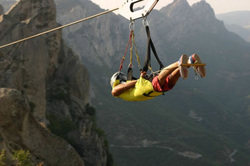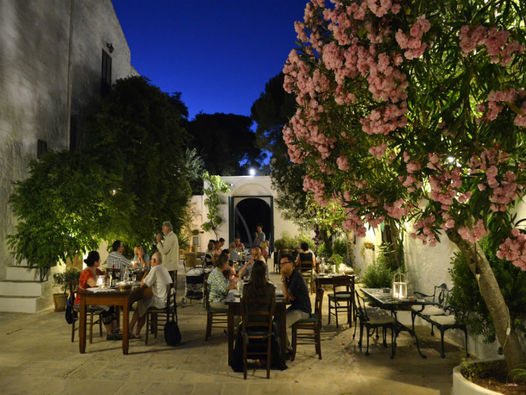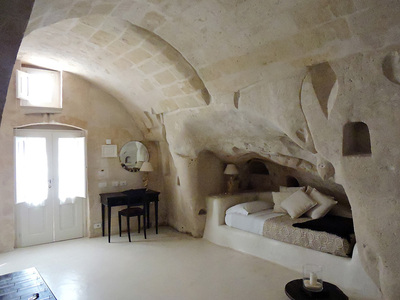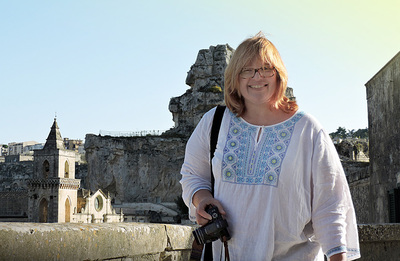 In Northern Italy, if you want to experience the rustic charm, fresh air and home grown richness of Italian food, you find an agriturismo to stay in. We stayed in two in Tuscany--one which was family owned and run and who grew and produced their own wine and olive oil. The other was a more bastadized, corporate owned affair, caharging extra for vineyard tours and tastings, with an over priced little restaurant on site and overpriced low quality "tourist wine". There are still others who are much more authentic--and where you can participate in taking care of animals, tending crops or making cheese, pasta and such. When traveling in Southern Italy the equivalent is staying in a masseria. Most masserie are very old... built between the 1500-1600s when Spain ruled the South. A masseria is a rather large farm complex to house not only the landowners, but also the peasants who tended the crops and farm animals. The complex usually included several other specialty buildings to house animals, to store crops, to make wine or cheese, etc. Some masseria developed into essentially small villages surrounded and protected high walls with a central courtyard surrounded by all the other structures. Many of the masserie today have been renovated and turned into vacation rentals and are mostly found in Puglia, in eastern Campania, on the plateau--or Murgia--of Basilicata, in Calabria, and in Sicily, Abruzzo and Molise. A masseria gives Voyagers a vacation that combines nature, local culture and home-grown (or Slow Food) cuisine with all the creature comforts of a world class vacation rental. You'll find modern plumbing, air conditioning (although often not as cool as we Americans would like it) and internet (slow or limited wireless connections due to thick walls), and satellite TV (often limited on station offerings). Some of the overly developed (in my opinion) masseria even offer spa treatments, golf courses and other offerings that have little to do with saturating yourself in local flavor or customs. I'd avoid these "resort" types and search for facilities that offer a more genuine Southern Italian experience. If you find a family run masseria you will find people go out of their way to make your stay a comfortable, memorable one. That was out experience when we stayed in a similar place, a small masseria of Trulli (pointed stone houses). Southern Italians are simply more hospitable than up in the North. There, I've said it.  Masseria il Frantoio, Ostuni, Puglia Masseria il Frantoio, Ostuni, Puglia When staying at a masseria, you will get the feel of a farm along with a definite level of comfort found on a country estate. I think this is a great way for Southern Italians (if they are the ones who developed and run the properties) to preserve and reuse these historic structures, along with preserving this period of history in Southern Italy. If you decide to book a stay in a masseria, you will most likely be welcomed like family members, sample their own olive oil and wine and even cheese made on these farms (beware of Ricotta Forte!). You will also learn about the local culture and history--of Puglia, Basilicata or Campania. Owners will often join guests for home-cooked dinners using products from the farms... many types of pasta with vegetables, parmigiana di melanzana, seafood (the sea is all around in the South), pizza made in outdoor wood ovens, roasted vegetables, insalata caprese, polpette (meatballs) or beefsteak, home made breads (they use salt in Southern bread, unlike the Tuscan breads), thick jam-like honey, and to drink... good Southern varieties of red wine (Primativo is out favorite!). I strongly suggest looking for an organic masseria that uses no chemicals to grow their olive trees, vines, cherries, almonds, and vegetables. You will not believe how simply food can taste so damned wonderful. Imagine having a real Italian family meal—excellent, simple fare pared with a great local wine and great, hand-waving conversation. You will never have experiences like these staying in hotels.  Pasta making at Masseria Panareo Pasta making at Masseria Panareo Some masseria offer classes in cheese making, pasta making, cooking or show you how olive oil is made. Visit in the fall and help with the harvest or grapes, almonds or olives. Some of the largest and oldest olive trees grow in the South... I took a photo of Lucas standing with a 2000 year old specimen! There are many masserie throughout the region and accommodation ranges from simple apartments to luxury suites and even trulli (circular stone huts), and most are in peaceful settings in the countryside surrounded by olive groves and vineyards. You usually need a car (rent in Bari or Naples) to access them and some can be difficult to find but it’s worth it for such unique accommodation and the opportunity to experience the warm hospitality of Southern Italians. If you want to stay in an organic masseria, use those words on Google... "organic masseria" and see what you come up with. The cost for a stay in a masseria stay might run from $60 to over $200 a night per person including breakfast.
--Jerry Finzi If you enjoyed this post and found it useful, please share out site with your friends. Grazie.
1 Comment
 Lisa and Lucas strolling with our hotel in the background on the right. Lisa and Lucas strolling with our hotel in the background on the right. I made an interesting choice this time... a night in a luxury cave hotel. Matera is a town in southern Basilicata (in the boot's ankle bone) where as far back as 40,000 years people lived in caves. There are even ancient churches and pagan temples in caves here. Back in the fifties the Italian government moved all the people out of the cave home because of poverty and disease. They built a new town up the hill... nowadays it is a fairly large city with its historic Sassi sections. Sassi means stones... the term for these unique homes carved from the mountain. At first we couldn't get to our hotel... Tommy kept directing us into a pedestrian zone crowded with people here for a hot air balloon fest. The the fiesty gps directed us to enter a dreaded ZTL (zona traffico limitata)... where cameras capture your plates and you get an expensive summons six months after returning to the U.S. We called the hotel and they said to drive through the ZTL and they will give the police our plate number.. no ticket. I guess we'll see after six months. The hotel is chic and very stylish... the room they gave us was up several flights of exterior stairs... whew. They had someone to carry luggage but still... what a climb on rustic stone steps. I mentioned to the porter something about my bad knees slowing me down and before I knew it, we had switched rooms to a larger suite lower down with a huge walk-in shower and bigger rooms. The air conditioning was barely working... the Italians aren't into chilled anything. We walked the village and looked across the gorge to where the paleolithic caves are...lots of them. There is a church carved into the rock cliff above the Duomo. We bought a clay water vessel whistle for Lucas in the piazza outside the Duomo. You fill it with water... blow into the spout... and it sounds like a bird's warbled song. Oh, and I got myself nice clay ocarina. I collect instruments of all types. This is a little treasure. Next, we walked through an archway next to the duomo toward the Sassi Museum. This was very interesting and reminded us that these sassi used to be the homes for people--and livestock--up until the 1950s when the government decided to move all the people to modern (and sterile) apartment blocks in the newly built part of town--away from the gorge. Instead of moving them, I think they should have helped them modernize their homes to have healthier places to live. There is a movement today to take back control of the sassi from hotel developers and international investors and put the descendants back into their sassi homes. We first tried to go into a nice restaurant with a good menu... we walked in and all of a sudden about 7 waiters snapped to attention and looked toward us. I said, "Tutti per me?" (All of you this, for me?) No one laughed. One look at us and they claimed the restaurant wasn't opened yet. It was after 7pm so I thought it should be. Then I got it. The white shirted and tie waiters, the white table cloths. Sure, for someone else (who didn't happen to be wearing shorts), they might be open. For us, no. Seriously, this was the impression I got. SO... we found another small, modern place called Panecotto (literally, Cooked Bread)... and that was their specialty--stale bread country soups. I had a bean soup with stale bread and sausage. Definitely something to try at home. We also had an assortment of bruschette, cacciocavallo and ham. The restaurant was in a renovated cave. Pretty cool. Afterwards when paying I noticed what I though was Altamura bread--with the brown crust and looking like a floppy chef's hat. (Then I realized the bread on our table was the same). I asked about it and I was corrected immediately. "E la pane di MATERA!" These people are really passionate about their local versions of bread. It sure tasted the same as Altamura bread.  Very fancy, and HOT cave dining room. Breakfast was feh. Very fancy, and HOT cave dining room. Breakfast was feh. The next morning we had a chic so-so breakfast in a white on white cave deep in the bowels of the hotel... VERY deep. It was like a rabbit warren of passages and steps. And it was very hot, with Italians coming into breakfast wearing puffy quilted jackets or sweaters. It's been mid-seventies to over eighty the last few days... and WE have longed for each cool evening while the locals put on winter coats an scarves! There was no ventilation in the dining rooms at all, and everyone was SO quiet while they ate. We were compelled to whisper. I whispered to Lucas that one of us should let out a loud burp or fart to wake everyone up! (We didn't). We walked out to the balcony and saw hot air balloons launching over the canyon. There was a balloon festival across the canyon that we knew nothing about. What timing. We then packed and loaded up and headed out across the canyon to see the view looking back toward this sassi town. It's like a little Grand Canyon with a village clutching its edge. We even found a cave church over there... Next stop... a two night stay in a trullo. A cone shaped house known only in this part of the world... Jerry F. To get out of Amalfi we had to put up with more twisty madness and twisted drivers. I can't describe how dangerously these fools drive considering the narrowness of the roads and the abundance of blind curves. Lisa shot a video that captured the insanity... including a near head-on collision. Once we headed south of Sorrento on the highway, things became more normal... well almost.  Over half a mile long and 400 feet high---one of the many bridges in Basilicata. Over half a mile long and 400 feet high---one of the many bridges in Basilicata. The highway was six lanes wide in places. Ahh... cruise control, come to Babbo. Actually, I was amazed that the South had such a great highway--huge bridges crossing over deep ravines, and lots of tunnels going through the mountains. Italy has always turned their backs--and the government wallets--on the South. But, get this... every several miles there were lane closures, switching lanes over to the opposite side of the highway, with no construction or workers in sight. There was one such detour that funneled 3 lanes down to a single narrow lane, with concrete and metal guard rails that were inches wider than my Volvo XC60 SUV. I actually stopped completely... thinking I was going to scrape the sides of the car. The collision sensor was making that flat line sound! I JUST made it... and somehow the small box truck behind me made it, too. This stuff is nuts. Anyway, the rest of the drive to Castelmezzano was beautiful. Bigger and more rugged mountains lined our path. This was like the West in the U.S.... big sky and mountains. Some were bald and rocky, others were forested. Then there were dizzyingly high peaks with villages clinging to their cliffs.  So close and yet so far: Romagnano al Monte ghost town. So close and yet so far: Romagnano al Monte ghost town. We took a side detour to a ghost town I had heard about hanging on one of these sort of cliffs, 2000 feet above a steep valley. It became a ghost after an earthquake decades ago. But as we pulled into the village some officials were just leaving and locking a huge gate that had been recently installed. They said it was to protect the historic site from vandals and that it was too dangerous. I had seen lots of pics from people visiting this site and we had supplies for a picnic overlooking that incredible view. They must have locked the place up fairly recently. What a shame. The men were very nice and their leader told us to follow one of their cars to a nearby rustic picnic area that turned out to be really nice. Bread, olives, cheese, tomatoes, fruit, "gassata" (sparking water) and Fanta... lunch was simple but great. (By the way, Fanta here is NOT like the chemical tasting stuff in the U.S. It actually has orange juice from Italian oranges in it. Very light and refreshing.)  Flight of the Angels Flight of the Angels Pulling in to Castelmezzano was great... uphill twisty roads but more sheep than crazy drivers. Our first views took our breath away. What a mystical setting. A village tucked under amazing dolomite pinnacles. We were able to pull right up to the hotel an unload... parking a short walk down in the village parking. The reception was on the 5th floor... our room was down on the first. At the desk, Lucas tasted the huge block of salt that someone turned into a glowing lamp. Salty with a soft glow. This was an upside down, fairly modest hotel clinging to a cliff with views of the dolomites outside our windows. At least there was an elevator. Dinner was a bit stuffy and formal but food was good. As this was mid October, the hotel seemed to have only 3 rooms booked. I suppose they get busy in the summer with people flocking here to do the zipline (more on that below). Afterwards the highlight was walking the passagiata with the locals (we were the only tourists) and coming upon the piazza overlooking the cliffs and village just as all the lights were lit. A Christmas village illuminated right before our eyes. I got some great pics using my tiny backpack tripod. We then walked a bit on the little streets, so narrow that you had to hug the walls if a small car came past. The next morning we drove to the nearby sister clifftown of Pietrapertosa via an amazing twisty and dangerous road (one part was undercut from a landslide... I drove quick over that.) Even this drive was an enjoyable adventure with just us on the roads--aside from the sheep and goats. I tried taking a photo of a line of sheep heading toward our road to cross... as soon as I got out of the car I heard one of the "sheep" give two sharp barks. It was the sheep dog warning of the danger. The sheep stopped dead in their tracks and would not move as long as the didn't get the all clear. The views of Pietrapertosa were even more astounding than Castelmezzano. I'll be sure to post some pics... words can't do it justice. The pinnacles were ornate and many. Some looked like faces... others just impress with the volcanic uplift that created them. The views from the road is amazing. In some parts of the village the cliffs lean and hang right over the houses! There is even a zipline that runs between the two towns called the Flight of the Angel (volodellangelo.com). You lay flat in a harness--Superman style--and fly at over 70 MPH! I had hoped to do it myself but it was a bit of a logistic problem... You need to decide which direction you want to travel in. There are lines going both ways but in different locations due to the downward pitch of the line needed to go from one town to the other. I couldn't figure out how to get back and forth--and one of the roads between the two towns is closed. (Yea... that's my story and I'm stickin' to it... yea, that's the ticket.) We then drove into a broad high plateau to move to our next amazement... the cave city of Matera, where we would spend the night in a cave hotel.... --Jerry F. P.S. If you enjoyed reading this post, please LIKE us on Facebook and SHARE it with friends who might be interested. Gratzie! Our next step of our voyage will take us into relatively unknown territory--unknown to most Americans, that is. This is a rugged, natural area of Italy with its own versions of Macchu Picchu-like villages up among the cliffs and clouds.
|
Categories
All
Archive
June 2024
|























 RSS Feed
RSS Feed
